|
Overview: 
Life Cycle Stages:
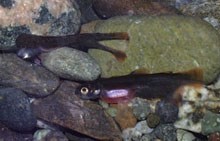
NPS photo 1 & 2: Eggs & Alevins 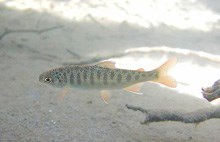
Roger Peters - USFWS Fry swim to the surface of the water, fill up their swim bladders with oxygen, and begin to feed. Depending on the species, fry can spend up to a year or more in their natal stream. Upon emerging from the gravel, both pink and chum are already silvery smolts, and head directly to sea. Sockeye fry tend to migrate to a lake, spending 1-2 years before migrating to sea. Chinook fry usually spend less than 5 months in freshwater, while coho fry may spend over a year. The survival of fry is dependent upon high-quality stream habitat. Boulders, logs, shade, and access to side channels is important in allowing fry to hide from predators and prevents them from getting flushed downstream during flood river-flows. 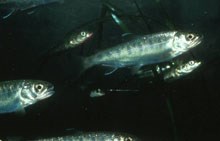
nps photo Eventually, environmental cues cause fry to begin their migration downstream towards the oceans. At this time, smolting begins, and scales grow as they turn a silvery color. At night to avoid predators, small fry (or developing smolts) allow the river to take them tail-first downstream while larger fry swim actively towards the ocean. Estuaries, at the mouth of the river, are crucial to the survival of young smolts. While allowing their bodies to adjust to the new conditions, they feed heavily, hoping to ensure survival in the ocean. 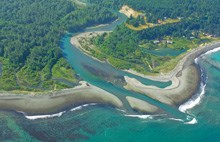
nps photo While some salmon remain in coastal water, others migrate northward to feedings grounds. Salmon may spend one to seven years in the ocean. Certain species have more flexible life history strategies, while others are more rigid. Chum may spend up to seven years at sea, but typically four. Pink salmon, on the other hand, spend a fixed 18 months at sea. Sockeye typically spend two years at sea, coho spend about 18 months, and chinook can spend up to 8 years before journeying back to their natal streams to spawn. 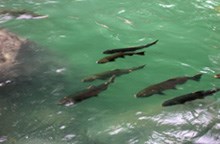
nps photo It is unknown how exactly salmon detect their natal streams, though it is suspected that scents and chemical cues, as well as the sun, play an important role in the homeward migration. Once the salmon reach freshwater, they stop feeding. During the course of the journey, their bodies instinctively prepare for spawning. The taxing journey draws energy from their fat storage, muscles, and organs, except for the reproductive organs. Males develop hooked noses, or kype, in order to fight for dominance. 
nps photo 7 & 8: Spawning & Death |
Last updated: April 11, 2025
